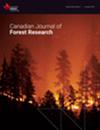Determining the effectiveness of using acoustic velocity as an indirect measurement of branchiness in standing longleaf pine
IF 1.5
3区 农林科学
Q2 FORESTRY
引用次数: 0
Abstract
Branches reduce stem quality, and the level of the effect is determined by the geometry, size, and number, of associated knots. Quantifying branchiness is difficult, as visual estimates are subjective, and mechanical measurements are impractical. Acoustic velocity (AV) is a relatively novel measurement capturing the speed stress travels through wood. AV is correlated with wood stiffness and is affected by internal characteristics like knots. This project tested AV as an indirect branchiness metric by measuring AV, height, diameter, and counting branches classified by diameter on 255 standing 8 year old longleaf pine ( Pinus palustris). AV was highly correlated with height (r = 0.76, p < 0.0001) and slenderness (r = 0.52, p < 0.0001). AV was moderately correlated with large living branches (diameter > 2.54 cm) (r = −0.27, p < 0.0001), but not correlated with total branches. Height, slenderness, and the count of large living branches (diameter > 2.54 cm) were included in the selected model for AV. Inclusion of dead or small (diameter < 2.54 cm) branches reduced model power. The best model captured 11% of the variation in AV, of which branches explained 5%. We conclude that AV does not appropriately quantify individual tree branchiness, but may be suitable for comparing populations such as families or provenances.用声速间接测量直立长叶松枝条的有效性
树枝会降低树干的质量,而这种效果的程度取决于相关结的几何形状、大小和数量。量化分支是困难的,因为视觉估计是主观的,而机械测量是不切实际的。声速(AV)是一种相对新颖的测量方法,用于测量应力在木材中的传播速度。AV与木材刚度相关,并受内部特性(如结)的影响。本项目通过测量255棵8年生长叶松(Pinus palustris)的树径、高度、直径和按直径分类的枝数,对树径作为间接分枝度量进行了检验。AV与高度高度相关(r = 0.76, p 2.54 cm) (r = - 0.27, p 2.54 cm)被纳入AV选择的模型中。包括死枝或小枝(直径< 2.54 cm)降低了模型的有效性。最好的模型捕获了11%的AV变化,其中分支解释了5%。我们得出结论,AV不能适当地量化单个树枝,但可能适合于比较群体,如家庭或种源。
本文章由计算机程序翻译,如有差异,请以英文原文为准。
求助全文
约1分钟内获得全文
求助全文
来源期刊
CiteScore
4.20
自引率
9.10%
发文量
109
审稿时长
3 months
期刊介绍:
Published since 1971, the Canadian Journal of Forest Research is a monthly journal that features articles, reviews, notes and concept papers on a broad spectrum of forest sciences, including biometrics, conservation, disturbances, ecology, economics, entomology, genetics, hydrology, management, nutrient cycling, pathology, physiology, remote sensing, silviculture, social sciences, soils, stand dynamics, and wood science, all in relation to the understanding or management of ecosystem services. It also publishes special issues dedicated to a topic of current interest.

 求助内容:
求助内容: 应助结果提醒方式:
应助结果提醒方式:


